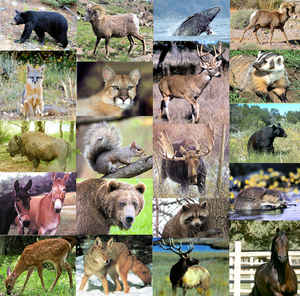
Connecticut Symbols
Connecticut State Animal
Sperm Whale

(Physeter Macrosephalus)
Adopted in 1975
The Sperm Whale was designated as Connecticut state animal by the General Assembly in 1975. It was selected because of its specific contribution to the state's history and because of its present-day plight as an endangered species.
The Sperm Whale is the largest of the toothed whales,
growing up to 60 feet in length and capable of diving over 3,000 feet in search of the squid and cuttlefish on which it feeds. The sperm whale's brain
is the largest of any creature that ever existed on earth. The great American novelist Herman Melville wrote about these creatures in his famous book
"Moby-Dick."
During the 1800's Connecticut ranked second only to Massachusetts in the American whaling industry. The sperm whale was the species most sought after
by Connecticut whalers circling the globe on ships out of New London, Mystic and other Connecticut ports to bring back needed oil for lamps and other
products.
Connecticut State Animal: Sperm Whale

The sperm whale (Physeter macrocephalus), or cachalot, is the largest of the toothed whales and the largest toothed predator. It is the only living member of genus Physeter, and one of three extant species in the sperm whale family, along with the pygmy sperm whale and dwarf sperm whale of the genus Kogia.
A large, blackish-brown whale with huge head and truncate snout; lower jaw small, long, and slender, the symphysis extending half the length of rami; the single blowhole on anterior left edge of snout; no dorsal fin, but conspicuous hump; eye very small, low, and near angle of mouth; pectoral fin short and relatively broad; upper jaw lacking functional teeth; lower jaw with 22-24 large, sharp teeth on each side. Total length of males, up to 20 m; females much smaller. Weight of a male 13 m long, 39 metric tons.
Habits of the Sperm Whales

Sperm whales are highly migratory, especially the males. Adult males move into high latitude temperate waters during summer, leading a solitary lifestyle, while females remain grouped in tropical or subtropical waters. In winter, the bulls return to lower latitudes for mating.
These whales regularly dive to depths of 1,000 m but are known to reach depths of over 2,100 m and may be capable of dives to 3,000 m. At such depths
these remarkable animals hunt their primary prey - squid. Much speculation has arisen concerning the feeding method of sperm whales as no light penetrates
to the depths these whales dive, and squid are highly elusive swimmers. The whales may feed by ambushing prey as they lie relatively motionless near
the ocean floor, attracting squid with a bioluminescent glow emanating from their mouth, or perhaps by stunning prey with ultrasonic sounds. Due to
the great depths at which these animals feed, the exact method of the sperm whale's feeding habits has yet to be determined. These whales are known
to produce a variety of "click sounds" occurring in sequence and termed "codas." Such sounds are probably used in echolocation and may play an important
role in locating prey while feeding.
Up to 1 metric ton of squid per day is required to sustain a single sperm whale. Other than squid, these whales occasionally consume other deep water
prey including octopus, lobsters, crabs, jellyfish, sponges, and several varieties of fish.
Breeding behavior in sperm whales is similar to harem formation - a single, dominant male accompanies a group of females and defends the group against
competing males. During this time, smaller males are driven off to form their own "bachelor groups" and battles between rival males for control of
the harem may occur. Twenty to thirty females may comprise a harem but many of them may already be pregnant or tending young. The gestation period
is approximately 15 months, the period of lactation is 1-2 years, and there is a "resting period" of up to 10 months following weaning before the females
will mate again. The breeding cycle therefore, may take as long as 5-7 years.
Newborn sperm whales are about 4 m in length and weigh approximately 1 metric ton. Although twin calves are known, a single calf per female is believed
the rule. Sexual maturity is reached at about 10 years of age.
Sperm whales were once the mainstay of the pelagic whaling industry. Prior to the advent of cannon harpoons, diesel-powered catcher boats, and massive
factory ships, the hunting of sperm whales was a dangerous occupation. Sperm whales are known to have effectively fought back on occasion - one even
sank an American whaler, the Essex, in 1820. In spite of the danger, sperm whales were hunted the world over for the array of valuable products these
whales contained - whale oil for lamps and lubricants; spermaceti (oil from the forehead) for high quality, smokeless candles; and ambergris, a waxy
by-product of digestion which was used in the manufacture of fragrances. By the early twentieth century, whaling had become an efficient, "wide open"
business that threatened not only the sperm whale, but all of the great whales, with extinction. Finally, in the 1970s whaling was banned worldwide.
Connecticut Law
The law designating the perm whale as the official Connecticut state animal is found in the General Statutes of Connecticut, Title 3, Chapter 33, Section 3-109a.
TITLE 3 STATE ELECTIVE OFFICERS
CHAPTER 33 SECRETARY
SECTION 3-109a
Sec. 3-109a. State animal. The sperm whale, Physeter macrocephalus, shall be the state animal.
(P.A. 75-165; P.A. 86-403, S. 6, 132.)
History: P.A. 86-403 made technical change re scientific name of sperm whale.
Taxonomic Hierarchy: Sperm Whale
Kingdom: AnimaliaPhylum: Chordata
Class: Mammalia
Order: Cetartiodactyla[a]
Infraorder: Cetacea
Parvorder: Odontoceti
Family: Physeteridae
Genus: Physeter - Linnaeus, 1758
Species: P. macrocephalus







